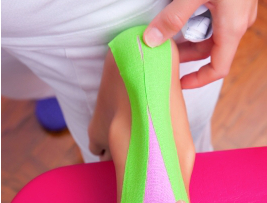Kinesiotape versus Non-elastic tape for ankles
Written by: Paul Kochoa, PT, DPT, OCS, CKTP, CGFI
In the Journal of Orthopeadic and Sports Physical Therapy, there was a study comparing the effects of kinesiotape with regular non-elastic athletic tape on ankles during an inversion perturbation. The results may surprise you.
First, let’s define some things. An “inversion perturbation” is basically when a subject was standing on one leg on a rocker board, and that board was moved suddenly in the direction that would commonly cause a lateral ankle sprain, the foot turns inward. Non-elastic athletic tape is the commonly used white cloth tape that most athletes use to tape a body part prior to a sports activity. Kinesiotape is a latex-free, elastic tape that can stretch up to one and a half times its length, and has been used for various purposes. For this study, it was used to facilitate the contraction of the fibularis muscle, the muscle on the outside of the ankle that makes the foot turn out, this action is called eversion, the opposite of inversion. Thus, contraction of this muscle in theory, would prevent a lateral ankle sprain.
The study used thirty athletic males who had no injuries in the past six weeks and divided them into ‘stable’ and ‘unstable’ groups using a star excursion balance test, a valid and reliable measure for dynamic balance. The researchers measured the amount of activation in the fibularis muscle during the inversion perturbation during three situations: with cloth tape, with kinesiotape, and without tape.
What were the findings? Well, the most surprising one was that the highest fibularis muscle activity occurred with the white athletic tape, and there was no significant difference between the kinesiotape and without tape conditions. So what does that mean? The muscle that was monitored did not contract more with the kinesiotape than without tape, it showed the most activity with the plain athletic tape. The kinesiotape didn’t do what it was purported to do. True, the study did not measure the amount of muscular force, only muscle activity. But one of kinesiotape’s proposed uses is to facilitate muscle contraction through stimuli on the skin. Based on this studies, those claims appear to be unsubstantiated.
Does that mean that you shouldn’t use kinesiotape? Not really. The study used young, male athletes who had no previous injuries to their ankles. Anecdotally, I’ve used kinesiotape to increase proprioceptive feedback in my ankle patients with good success. It’s worked when I’ve used it for other purposes with other body parts. Kinesiotape was never meant to be as confining or restrictive as white athletic tape, and there are other uses for it other than just muscular facilitation. Remember, tape is just an adjunct to a good physiotherapy program, and should never replace it. Consult your medical professional if you have questions about which tape to use.
If you would like more information, please call Professional Physical Therapy and Training at 973-270-7417. Our offices are located within the YMCA locations in Madison and Summit, NJ. You do not need to be a member of the YMCA to visit with us.
Image courtesy of Ambro / FreeDigitalPhotos.net